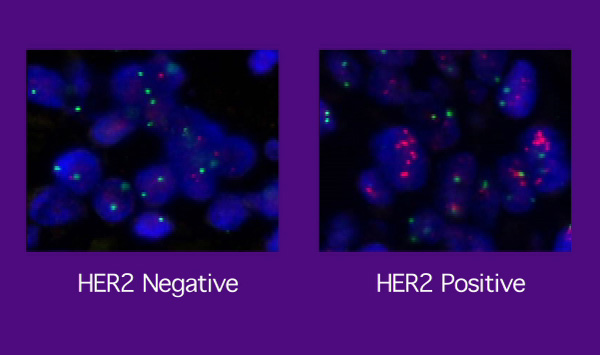
© Roche.comDevice can identify the protein HER2 status and isolate circulating tumor cells
Researchers have developed a new disposable device that could help identify patients with advanced breast cancer awaiting drug therapy with trastuzumab, and capture cancer cells that have an abnormal amount of the protein HER2 (typically found in aggressive breast cancers).
Benjamin Thierry, of the Ian Wark Research Institute at the University of South Australia, along with his colleagues, has created an elastic, disposable microfluidic device that can efficiently catch the protein HER2 - which is the tyrosine kinase human epidermal growth factor receptor 2 -- found in "aggressive breast cancers with poor prognosis."
The only way to find out HER2 status in breast cancer patients now is through fluorescence
in situ hybridization (FISH) or immunohistochemistry, both of which require biopsies. The problem with biopsy-based testing is that it could lead to treatment that is ineffective, because the HER2 status of the primary tumor in 20 percent of breast cancers differs from the HER2 status in that of a metastatic tumor. This information has led to the idea of isolating circulating tumor cells (CTCs), but this is difficult because circulating tumor cells exist at very low ratios of 1 to 10 per billion blood cells.
Establishing HER2 status is very critical because HER2 positive breast cancer patients have benefited from drug therapy with trastuzumab (Herceptin), which are humanized monoclonal antibodies against HER2. It also decreases recurrence risk by half. Also, the side effects and cost (which is approximately $50,000 to $65,000 in the U.S.) makes it a priority to identify patients who are HER2 positive.
Now, Thierry and his colleagues' device has the ability to detect the status of HER2 and help capture circulating tumor cells. The device is made of organic silicon found in most contact lenses, and polydimethylsiloxane (PDMS), which are shampoos that are transparent, permeable to gasses, and compatible with soft molding techniques. The device also contains a polymeric layer on its surface, which has a large number of reactive molecules in it. Through the use of a plasma-based polymerization process, this layer can attach to proteins that are able to catch cancer cells while leaving normal blood cells alone.
"Microfluidic-based devices offer a unique opportunity to efficiently isolate CTCs from patient's blood, thereby opening a window on the pathophysiology of cancer and its progression," said Thierry. "We hope that our device will provide a fast, reliable and affordable methodology to establish HER2 status for breast cancer patients presenting metastases, thereby enabling the selection of more potent therapy based on trastuzumab.
"We are aiming to achieve clinical validation in the coming months and, with the support of a fellowship from the Prostate Cancer Foundation of Australia, to extend the study to the detection of aggressive forms of prostate cancer."
Thierry's device showed an 80 percent immuno-capture efficacy of HER2 positive cells, and is also cheaper and easier to make than previous microfabricated devices, which were developed to bind to cells of epithelial tissues where the cancer originated, ultimately isolating CTCs.

Reader Comments
to our Newsletter